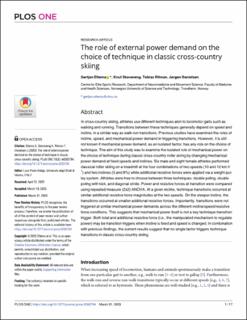| dc.contributor.author | Ettema, Gertjan | |
| dc.contributor.author | Skovereng, Knut | |
| dc.contributor.author | Ritman, Tobias Elvevold | |
| dc.contributor.author | Danielsen, Jørgen | |
| dc.date.accessioned | 2023-10-31T09:47:58Z | |
| dc.date.available | 2023-10-31T09:47:58Z | |
| dc.date.created | 2023-04-17T17:24:33Z | |
| dc.date.issued | 2023 | |
| dc.identifier.citation | PLOS ONE. 2023, 18 (3), . | en_US |
| dc.identifier.issn | 1932-6203 | |
| dc.identifier.uri | https://hdl.handle.net/11250/3099672 | |
| dc.description.abstract | In cross-country skiing, athletes use different techniques akin to locomotor gaits such as walking and running. Transitions between these techniques generally depend on speed and incline, in a similar way as walk-run transitions. Previous studies have examined the roles of incline, speed, and mechanical power demand in triggering transitions. However, it is still not known if mechanical power demand, as an isolated factor, has any role on the choice of technique. The aim of this study was to examine the isolated role of mechanical power on the choice of technique during classic cross-country roller skiing by changing mechanical power demand at fixed speeds and inclines. Six male and eight female athletes performed classical roller skiing on a treadmill at the four combinations of two speeds (10 and 12 km h-1) and two inclines (5 and 8%) while additional resistive forces were applied via a weight-pulley system. Athletes were free to choose between three techniques: double poling, double poling with kick, and diagonal stride. Power and resistive forces at transition were compared using repeated measure (2x2) ANOVA. At a given incline, technique transitions occurred at similar additional resistive force magnitudes at the two speeds. On the steeper incline, the transitions occurred at smaller additional resistive forces. Importantly, transitions were not triggered at similar mechanical power demands across the different incline/speed/resistive force conditions. This suggests that mechanical power itself is not a key technique transition trigger. Both total and additional resistive force (i.e., the manipulated mechanism to regulate power) may be transition triggers when incline is fixed and speed is changed. In combination with previous findings, the current results suggest that no single factor triggers technique transitions in classic cross-country skiing. | en_US |
| dc.language.iso | eng | en_US |
| dc.publisher | PLOS | en_US |
| dc.rights | Navngivelse 4.0 Internasjonal | * |
| dc.rights.uri | http://creativecommons.org/licenses/by/4.0/deed.no | * |
| dc.title | The role of external power demand on the choice of technique in classic cross-country skiing | en_US |
| dc.title.alternative | The role of external power demand on the choice of technique in classic cross-country skiing | en_US |
| dc.type | Peer reviewed | en_US |
| dc.type | Journal article | en_US |
| dc.description.version | publishedVersion | en_US |
| dc.source.volume | 18 | en_US |
| dc.source.journal | PLOS ONE | en_US |
| dc.source.issue | 3 | en_US |
| dc.identifier.doi | 10.1371/journal.pone.0283794 | |
| dc.identifier.cristin | 2141381 | |
| cristin.ispublished | true | |
| cristin.fulltext | original | |
| cristin.qualitycode | 1 | |

